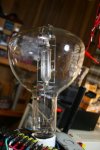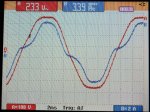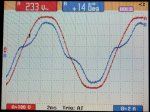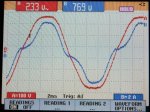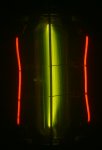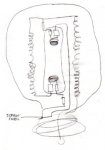181030-0911 EST
SG-1:
Several comments.
The current waveform is not symmetrical.
I would expect the construction of the mercury bulb portion and related current limiting resistors to be roughly symmetrical from a mechanical and wiring perspective. Your circuit diagram does not show that. I thought it would have symmetry also. I have re-checked the upper aux electrode is connected between the two filament resistors. The lower is connected directly to the screw shell.
In a gas discharge device at an instant of time one electrode is an electron emitter, a cathode, and the other electrode an electron receiver, anode. In a thyratron a hot cathode is the electron emitter, and the thyratron is a one way device, a controlled diode. Only the hot cathode is hot enough to emit electrons, and when polarity reverses the plate being much colder does not emit and thus no conduction. An ignitron is also a one way controlled diode. Here a mercury pool is the electron emitter with an ignitor rod to start conduction.
In a mercury vapor bulb both electrodes are both an electron emitter and receiver because both are hot and can switch roles from 1/2 cycle to the next.
Mercury vapor bulbs contain some excitable gas, like argon, that is used to get conduction going at a moderately low voltage. When the bulb is cold the mercury is condensed and pressure is low. The mercury is not in an excited state. The excited gas conducts at some moderate voltage defined by the pressure and warms the mercury. The warm mercury vaporizes, conducts, and temperature further rises as does pressure from the heat. Voltage goes up as pressure rises. More electrical power input from the higher voltage drop by about the same current set by input current limiting, more power dissipation in the conducting path, and more light output.
If your external circuit is unchanged, including the scope connection, and you rotate the bulb orientation 180 degrees in the vertical direction, then does the waveform change? Does the coincident zero crossing change from the negative slope to the positive slope?
.


